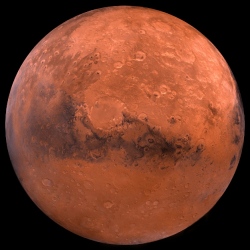
Scientists think they see evidence of two huge tsunamis having once swept across the surface of Mars. They point to satellite data suggesting a major redistribution of sediments over a large region at the edge of the northern lowlands. The US-led team argues that asteroid or comet strikes into an ocean of water could have triggered the giant waves.
Such events could only have occurred more than three billion years ago when the planet was wetter and warmer. Today, Mars is dry and very cold, and any impact would merely dig out a dusty hole. But researchers have long speculated that the low, flat terrain in Mars’ northern hemisphere could have hosted an ocean if the climate conditions were just right.
The nagging doubt with this theory has been the absence of an identifiable shoreline, something the new study could now help explain. If tsunamis regularly inundated the "land", dumping sediments and scouring new flow channels, they could over time have disguised what otherwise would have been an obvious "coast".
"Clearly, it’s one of the implications of this work: to have tsunamis, you must have an ocean," said Alexis Palmero Rodriguez from the Planetary Science Institute in Tuscon, Arizona.
"So, we think this is going to remove a lot of the uncertainty that surrounds the ocean hypothesis. Features that have in the past been interpreted as relating to an ocean have been controversial; they can be explained by several, alternative processes. But the features we are describing – such as up-slope flows including large boulders – can only be explained in terms of tsunami waves," he told BBC News.
Dr Rodriguez and colleagues’ tsunami findings appeared on Thursday in the journal Scientific Reports. Their work centres on two connected regions of Mars, known as Chryse Planitia and Arabia Terra. The team claims that the sediments observed by satellite betray the action of two ancient mega-tsunamis.
